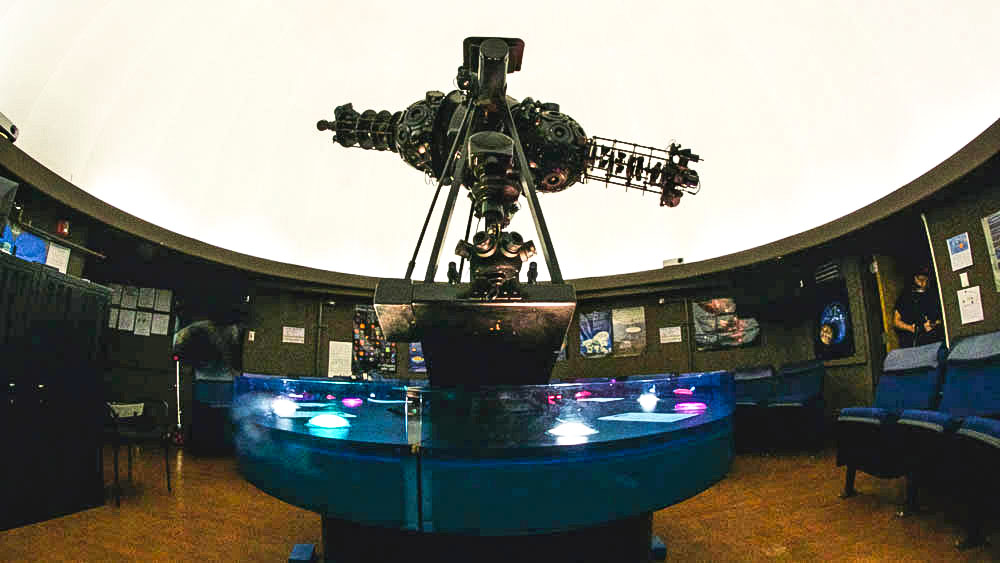The sky is the limit as UCLA planetarium reopens for in-person shows

The UCLA Planetarium reopened for in-person shows Wednesday after more than a year of virtual events. The public shows, run by astronomy graduate students, are free of charge and last around an hour. (Daily Bruin file photo)
By Yifan Gu
Nov. 12, 2021 2:41 p.m.
The UCLA Planetarium held its first in-person show since March 2020 on Wednesday.
The planetarium, which is on the eighth floor of the Mathematical Sciences Building, was finished in 1957. It includes a star projector installed in 1973 that has functionalities such as full-sky coverage of the entire celestial sphere, according to the planetarium’s website.
The planetarium show was titled “Powers of 10” and had about 16 attendees. The title stemmed from a documentary of the same name released about half a century ago, said Rory Bentley, a doctoral student of astronomy and astrophysics who hosted the show.
Virtual shows on various topics such as female astronomers, super-Earths and the formation of planetary systems occurred on Wednesday nights this year. Astronomy graduate students primarily present the shows. Public shows are free of charge and do not require reservations, according to the website.
Briley Lewis, a doctoral student of astronomy and astrophysics and planetarium show coordinator, said that the planetarium is completely student-run with help from a faculty advisor. Students are in charge of regular maintenance and holding shows which can be either open to the public or private events for schools.
For the “Powers of 10” show, Bentley first presented a slideshow displaying a picture of the planetarium and then zoomed the lens out gradually by a factor of 10 each time until the scale reached 10 to the power of 27 meters. The audience saw places from the UCLA campus, to where the Voyager 1 spacecraft is located, to the Andromeda galaxy and beyond.
After the presentation, the show included half an hour of sky observation. Bentley operated the star projector to show the audience the night skies in Los Angeles, New Zealand, Hawaii and Antarctica, and identify the locations of several celestial bodies, including the Milky Way and the Sagittarius constellation.
Bentley said that he chose the “Powers of 10” topic partly because it covered a variety of astronomical and scientific knowledge.
“We talked about planets, stars, galaxies, the Big Bang. We even got to atoms at one point at the very end,” he said.
Bentley said that he has been interested in astronomy ever since he was two years old and now studies under the tutelage of Andrea Ghez and Tuan Do, the former of whom won the Nobel Prize in Physics last year.
Bentley said that the important thing about planetarium shows is education, adding that one could share cool and interesting details without being too formal and academic.
Lizvette Villafaña, a doctoral student of astronomy and astrophysics, was another coordinator for the show Wednesday. She said that graduate students as possible future academics are responsible for increasing the diversity and accessibility of educational outreach work.
Sara Lehman, a second-year economics and communications student who attended the show, said that the projector is a nice way to observe the stars and that she most liked the moment when the projector was turned on and stars began to be displayed.
“I’m really glad to have this on campus,” Lehman said. “It’s a really unique opportunity.”
Nancy Ning, Leonardo Clarke and Grant Weldon are three doctoral students of astronomy and astrophysics who also attended the show. They said that they might give shows too, or come as attendees in the future.
Ning enjoyed the process of continually zooming out during the “Powers of 10” presentation.
“It’s a really great way of presenting things because it shows everything we study in astronomy,” she said. “You just see all those different objects, you see the structures.”
Clarke appreciated the Planetarium show because he grew up in a city with poor star visibility in the night sky due to light pollution. Weldon had been to one of the planetarium’s previous virtual shows in October, which was the first show in the 2021-22 school year and focused on exoplanets.
[Related: UCLA Planetarium hosts virtual show, plans for in-person relaunch]
Weldon enjoyed the connection between the first and last thirty minutes of the in-person show. The Andromeda galaxy, for instance, was discussed in the presentation and then displayed by the star projector.
Both virtual and in-person Planetarium shows will continue to occur Wednesdays, depending on the availability of the hosts, Bentley and Villafaña said.
According to the planetarium’s website, the next two shows are scheduled for Nov. 17 and Dec. 1 and will focus on the Milky Way’s supermassive black hole and launch month for NASA’s James Webb Space Telescope, respectively. Both upcoming shows are currently planned to be in person, Bentley said.
“We need to keep getting the word out that we’re open again,” Bentley said. “I expect for the next couple months, it’ll probably be a little bit less (busy) than normal, but we still had a good turnout today.”

